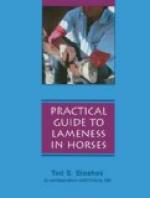In some cases practitioners are called to attend young animals that are reported to be “stifled” (often in young mules that have made a rapid growth) and upon arrival the only noticeable symptom of preexisting luxation is the soiled condition of the anterior fetlock region—evidence of its having been dragged. Such cases may be styled momentary luxation, whether they are due to a weakened condition of the patellar ligaments or spasmodic contraction of the crural muscles.
In upward luxation, reduction is effected by attempting further extension of the stifle joint and at the same time the patella is pulled outward, off the internal rim of the trochlea. This is attempted by securing the subject in a standing position; the sound side is kept against a wall if possible and a rope is tied to the extremity of the affected leg. Traction is exerted upon the rope and at the same time force is directed against the stifle joint to produce further extension if possible, so that the straight patellar ligaments may relax sufficiently to allow the patella to be dislodged from its position upon the inner trochlear lip. Failing in this manner of procedure, the affected animal is to be cast and anesthetized with chloroform. The relaxation which attends surgical anesthesia will permit of reduction of the dislocated bone and manipulations such as have just been outlined may be employed.
Following reduction in the average case it is essential that the subject be given vigorous exercise for a few minutes. Reduction having been affected, the application of a vesicant over the whole patellar region is customary.
In cases of habitual luxation, unless the ligaments are so lax that the patella may be displaced laterally over the inner as well as the outer trochler rims, division of the inner straight patellar ligament will correct the condition. This desmotomy has been advocated by Bassi, and good results in appropriate cases have been reported by Cadiot, Merillat and Schumacher. This operation has been found a corrective in cases of outward luxation as well as those of upward dislocation of the patella when resorted to before the trochleae are worn from frequent luxation.
Outward luxation of the patella is occasioned by a lax condition of the internal femeropatellar ligament or a rupture of the same so that the patella slips over the outer femoral trochlear rim and permits of an abnormal flexion of the stifle joint. The outer trochlear rim being the smaller of the two, inward luxation does not occur in the horse. With the patella disarticulated in this manner, the action of the quapriceps femoral group of muscles has no effect on the stifle joint and, therefore, flexion of this articulation occurs as soon as the subject attempts to sustain weight and the leg collapses unless weight is at once taken up by the other member if sound.




